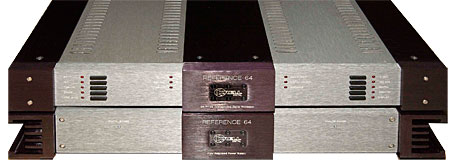| Columns Retired Columns & Blogs |
Krell Reference 64 digital processor
Remember the early days of CD, when some players were touted as having the revolutionary new "2x-oversampling" digital filters?
Those early oversampling players were the first to replace the analog output filter with one that operated in the digital domain, thereby avoiding the problems of steep analog filters. In fact, those analog filters were a significant source of unmusical sound in first-generation CD players, introducing severe phase shift, ringing, passband ripple, and often upper-treble attenuation. They were necessary, however, to remove the spurious images that appeared at multiples of the sampling frequency, and to smooth the stairstep waveform created by the reconstruction process.

Digital filters changed all that. Instead of putting a steep analog "brick-wall" filter after the DAC, the digital filter carried out the same function by performing mathematical operations on the digital signal within a chip. With filtering being performed before the digital/analog conversion process, designers could get rid of steep analog output filters, and their sonic problems.
Digital filtering had other advantages. The filter can generate new sample points between the original audio samples, thus multiplying the sampling frequency. This process, called oversampling, shifts the effective sampling rate from 44.1kHz to a multiple of 44.1kHz. A 4x-oversampling digital filter, for example, would interpolate three new sample points (generally set to zero amplitude) for each input sample, bringing the sampling frequency to 176.4kHz (4 x 44.1kHz). The spurious images at multiples of the sampling frequency still appear, but they are now shifted well away from the audio band, where they can be easily filtered (even by one with a gentle 6dB/octave slope that won't interfere with the audio signal). Today, virtually all CD players use digital filtering.
This brings us to the current state of digital audio reproduction. Most filtering today is performed by the 8x-oversampling NPC SM5803 or SM5813 filter chip or the equivalent from Burr-Brown, the DF-1700, a device found in about 90% of the high-end digital processors currently on the market. Designers have very few options when selecting a digital filter.
There's another way of implementing a digital filter: build your own. Custom filters are made with Digital Signal Processing (DSP) chips controlled by instructions telling the chips what to do to the audio samples. These instructions are the filters' "software," or filtering "algorithms," that determine the filters' characteristics. Changing the filter is as simple as changing the chip containing the software (or firmware).
This is exactly what Krell has done with the Reference 64 processor—but with a twist. Instead of oversampling at 8x, the Reference 64's filter operates at an astonishing sixty-four times sampling frequency, or 2.8224MHz. In fact, the Reference 64 has the highest oversampling rate of any digital filter in a digital processor. This route is expensive, exacting, and requires a high level of engineering expertise to accomplish.
How much better is this elaborate approach than using an off-the-shelf chip? Do digital filters have a large effect on a processor's sound? And are DSP-based converters worth the attendant high cost?
These questions were on my mind as I took a look inside this remarkable piece of engineering and warmed it up for some critical listening.
Technical description
The Reference 64 sports the entire Krell line's new styling. Dark gray-anodized aluminum panels are flanked by black aluminum sides, with a wide black panel running down the middle. The 64's appearance is serious and businesslike. (Incidentally, the Reference 64 replaces Krell's earlier SBP-64X processor.)
The 64 comprises two chassis stacked atop one another. The lower chassis is the power supply and the top chassis contains the processor. Large heatsinks running down the power supply's sides provide a good visual match for the processor's black side panels. Two blue LEDs on the power supply indicate if the analog and digital supplies are working, and red LEDs on the processor show that the analog and digital supplies are present inside the processor. Two rows of five buttons each run down the processor's front panel, providing input selection, polarity reversal, digital tape monitor, and selection of Krell's "Time Sync," a circuit that accepts a clock from a Krell transport on a separate line (more on this later). Each button is accompanied by a red LED to show that the function is engaged. Three additional LEDs indicate when the unit is locked to one of three sampling rates. All but one LED can be turned off with a front-panel button.
The rear panel has an unusual connection method between the power supply and processor. Instead of by cables, the connection is made by a metal panel with four D-connectors mounted to it. These D-connectors fit into D-connectors on the power supply and DAC, electrically joining the power supply to the processor. This arrangement also mechanically joins the two chassis at the rear. The processor's front feet fit into "shoes" on the power supply that lock the two chassis together at the front.
- Log in or register to post comments




































